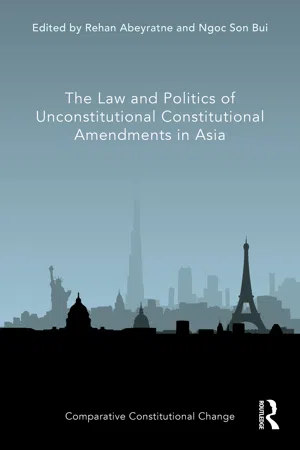
The Law and Politics of Unconstitutional Constitutional Amendments in Asia
Rehan Abeyratne, Ngoc Son Bui, Rehan Abeyratne, Ngoc Son Bui
- 306 pagine
- English
- ePUB (disponibile sull'app)
- Disponibile su iOS e Android
The Law and Politics of Unconstitutional Constitutional Amendments in Asia
Rehan Abeyratne, Ngoc Son Bui, Rehan Abeyratne, Ngoc Son Bui
Informazioni sul libro
This book explains how the idea and practice of UCA are shaped by, and inform, constitutional politics through various social and political actors, and in both formal and informal amendment processes, across Asia.
This is the first book-length study of the law and politics of unconstitutional constitutional amendments in Asia. Comprising ten case studies from across the continent, and four broader, theoretical chapters, the volume provides an interdisciplinary, comparative perspective on the rising phenomenon of unconstitutional constitutional amendments (UCA) across a range of political, legal, and institutional contexts. The volume breaks new ground by venturing beyond the courts to consider UCA not only as a judicial doctrine, but also as a significant feature of political and intellectual discourse.
The book will be a valuable reference for law and political science researchers, as well as for policymakers and NGOs working in related fields. Offering broad coverage of jurisdictions in East Asia, Southeast Asia and South Asia, it will be useful to scholars and practitioners within Asia as well as to those seeking to better understand the law and politics of the region.
Domande frequenti
Informazioni
Part I
Discursive model
2 The politics of unconstitutional constitutional amendments in Japan
The case of the pacifist Article 9
2.1 Introduction
2.2 Questions of constitutionality and constitutionalism in Japan
2.3 Article 9 controversy during the Cold War
Aspiring sincerely to an international peace based on justice and order, the Japanese people forever renounce war as a sovereign right of the nation and the threat or use of force as means of settling international disputes.
In order to accomplish the aim of the preceding paragraph, land, sea, and air forces, as well as other war potential, will never be maintained. The right of belligerency of the state will not be recognized.
Amendments to this Constitution shall be initiated by the Diet, through a concurring vote of two-thirds or more of all the members of each House and shall thereupon be submitted to the people for ratification, which shall require the affirmative vote of a majority of all votes cast thereon, at a special referendum or at such election as the Diet shall specify.